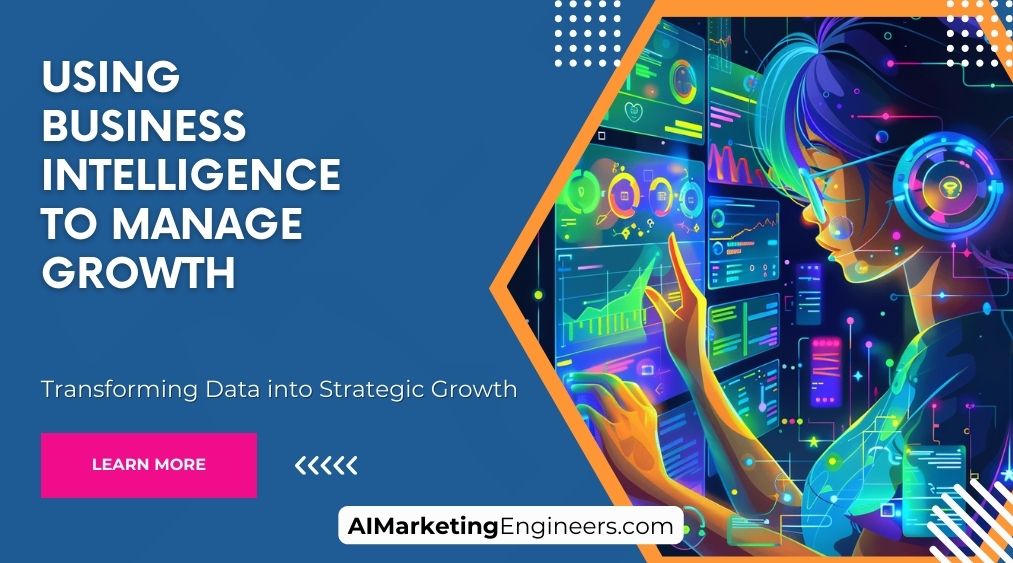Key Takeaways
✅ Data-Driven Decision-Making: Embracing Business Intelligence (BI) transforms raw data into a goldmine for informed decision-making. With 60% of organizations reporting improved efficiency through BI, it’s clear that leveraging data analytics leads to smarter strategies and outpaces intuition. By diving into the numbers, businesses can pinpoint exactly where improvements are needed, operational tweaks can be made, and strategic pivots can occur to keep pace with market demands.
✅ Increased Efficiency and Productivity: The automation that Business Intelligence solutions offer is a game-changer, streamlining the collection and analysis of data and freeing up valuable time. Stats reveal a 20% uptick in productivity in firms that integrate BI tools effectively. This advantage allows for the reallocation of resources to more critical tasks, optimizing efficiency and driving productivity to new heights.
✅ Improved Customer Knowledge and Experience: With Business Intelligence, understanding your customer has never been easier. A staggering 75% of businesses see an increase in customer satisfaction after deploying BI tools. Deep insights into customer behavior and preferences enable tailored marketing strategies, leading to enhanced customer experiences, increased loyalty, and, ultimately, a significant uplift in sales and revenue.
 Introduction
Introduction
Have you ever wondered how leading companies stay ahead of the curve? The answer often lies in their ability to harness Business Intelligence to manage growth effectively. In today's fast-paced market, staying informed and adaptable is not just beneficial; it's essential. Business Intelligence serves as the backbone for organizations aiming to thrive, not just survive.
This article delves into the crucial role of BI in shaping business landscapes by monitoring performance, optimizing operations, and enhancing customer experiences. We're setting the stage to explore not only how BI drives efficiency and productivity but also its impact on forecasting and strategic decision-making. Stay tuned as we unveil actionable insights and forward-thinking approaches designed to turbocharge your business's growth and keep you ahead in the competitive race. With these tools in hand, prepare to uncover strategies that promise not only to revolutionize your operations but also significantly boost your bottom line.
Top Statistics
| Statistics | Insight |
|---|---|
| Global Business Intelligence Market Size: Expected to grow from USD 23.1 billion in 2020 to USD 33.3 billion by 2025, at a CAGR of 7.6%. | This illustrates the rapid expansion of the business intelligence market, signaling a growing recognition of its value in strategic decision-making. |
| Business Intelligence Software Market Growth: Projected to grow by 5.71% (2024-2028), reaching a market volume of US$34.16 billion in 2028. | Indicates steady growth, assuring businesses about the sustainability and evolving capabilities of BI tools. |
| Market Share Concentration: In the US, top four companies generate between 40% to 70% of industry revenue. | Highlights the competitive yet concentrated nature of the market, hinting at the strong positions established by leading firms. |
| Industry Employees: The US Business Intelligence Software industry employs approximately 144,000 people. | Reflects the sector's scale and its importance as a source of employment, indicating robust industry health. |
| Global Forecast: Significant growth is forecasted for the Business Intelligence market during 2024-2031. | Demonstrates long-term confidence in the BI sector, suggesting ongoing innovations and increased adoption rates. |
What is Business Intelligence?
Business Intelligence (BI) is like the engine room of a modern-day business, equipped to make sense of a vast sea of data. It weaves together historical data, current operations, and predictive analytics to provide a comprehensive view of a business. The origins trace back to decision support systems of the 1960s, evolving over decades to today's highly sophisticated systems. At its core, BI systems consist of data sources, data analysis, data warehouses, and the BI engine, all culminating in the presentation or visualization of actionable information.
Benefits of Business Intelligence
The magic of Business Intelligence doesn't stop at just one or two benefits; it stretches across the entire canvas of a business. From a high-level viewpoint, BI helps in monitoring company performance and analyzing consumer data, to the granular details of detecting bottlenecks in supply chain operations. By tracking and analyzing every beat of the business, from employee output to labor costs, BI tools enhance productivity and decision-making. Predicting trends, optimizing business processes, and increasing sales and revenue, are just the tip of the iceberg. In the hyper-competitive business world, gaining an edge is paramount, and that's precisely what BI tools offer.
How Business Intelligence Works
Imagine having a conversation with your business data and asking it all kinds of questions. That's BI at work. It starts with collecting and storing data from myriad sources, then dives deep into this data using various tools and techniques like data mining, reporting, and data visualization. The cherry on top is the presentation of insights through dashboards and reports that speak directly to stakeholders. This process enables businesses to not just see what's happening now, but also to predict future trends.
Challenges and Mitigation Strategies
Despite the allure of transforming data into gold, using BI is not without its challenges. Data comes from everywhere, and managing these fragmented pieces to make a whole picture can be daunting. The costs of BI tools and integrating them into existing systems also pose a hurdle. Moreover, to truly harness the power of BI, a business needs to align its BI strategy with its organizational goals. Thankfully, with thoughtful planning and execution, these hurdles can be overcome, paving the way for effective BI adoption.
Maximizing Growth through Business Intelligence
The endgame of BI is fueling growth by making smart, data-driven decisions. By understanding customer behavior, predicting trends, and identifying challenges and opportunities, businesses can stay two steps ahead. BI tools shine a light on problems within organizations and lay down the groundwork for developing strategies for growth. In essence, BI doesn’t just help businesses grow; it helps them grow wisely.
Business Intelligence Tools and Software
With a plethora of BI tools like Ruler, Qlik Sense, and Yellowfin on the market, each comes with its own set of bells and whistles. Ruler, for instance, excels in tracking marketing outcomes, while Qlik Sense simplifies complex data analysis with its intuitive user interface. Yellowfin, on the other hand, is known for its advanced data visualization capabilities. Choosing the right BI tool boils down to understanding specific business needs and goals, ensuring that the tool not only fits but enhances the business's ability to make informed decisions.
In sum, Business Intelligence stands as a beacon guiding businesses through the complex maze of data towards growth, efficiency, and competitive advantage. By understanding and applying BI with precision, businesses can unlock the full potential of their data to foster informed decision-making and strategic planning.
AI Marketing Engineers Recommendation
Recommendation 1: Leverage Real-Time Data for Immediate Insights: In today's fast-paced market, the ability to make quick, informed decisions is essential. By Using Business Intelligence to Manage Growth, companies can tap into real-time data analytics to gain immediate insights into consumer behavior, market trends, and operational efficiencies. According to a recent survey, businesses that utilize real-time analytics are twice as likely to report significant improvements in decision-making compared to those that don’t. Harnessing this power allows for the rapid adjustment of strategies, ensuring businesses remain competitive and agile.
Recommendation 2: Integrate Predictive Analytics to Anticipate Market Changes: The future belongs to those who prepare for it today. Predictive analytics uses historical data, AI, and machine learning algorithms to forecast future trends and behaviors. In the context of Using Business Intelligence to Manage Growth, implementing predictive analytics can help companies anticipate market shifts, understand customer preferences, and predict sales trends with remarkable accuracy. Industry data shows that companies leveraging predictive analytics have seen a 21% increase in organic revenue growth compared to competitors who don't. This strategic insight not only provides a competitive edge but also enhances strategic planning and risk management.
Recommendation 3: Utilize Business Intelligence Tools for Enhanced Data Visualization: Data is only as good as its interpretation. Business Intelligence (BI) tools take complex data sets and transform them into intuitive, visually engaging reports and dashboards. This practical application is crucial for Using Business Intelligence to Manage Growth as it democratizes data, making it accessible and understandable to stakeholders across different levels of an organization. Tools like Tableau, Microsoft Power BI, and Google Data Studio offer capabilities ranging from real-time updates to predictive modeling, facilitating informed decision-making. Companies that invest in BI tools not only report a 22% reduction in operational costs but also enjoy enhanced productivity by simplifying data analysis and sharing.
Conclusion
In the landscape of today’s fast-paced business environment, Business Intelligence (BI) emerges not just as a tool but as a beacon guiding companies through the complexities of growth management. It encapsulates more than just a set of technologies; it represents a coherent strategy to harness data for steering decision-making processes, optimizing operations, and ultimately securing a competitive edge in the marketplace. From the in-depth exploration of what BI entails to the nuanced understanding of its benefits, it's clear that leveraging BI is paramount for companies aiming to thrive.
The journey through the evolution, workings, and benefits of BI underscores the transformative power of data when intelligently harnessed. The ability to monitor company performance, antsly analyze consumer data, and pinpoint operational inefficiencies offers a clear blueprint for driving business success. Moreover, navigating the potential challenges and aligning BI strategies with organizational goals paves the way for not just incremental improvements but substantial, sustainable growth.
Yet, integrating BI into the fabric of an organization is not without its hurdles. Addressing fragmented data sources, managing costs effectively, and ensuring that BI strategies mesh with the company's broader objectives require careful consideration and tactical planning. However, the payoff—manifested in increased efficiency, sales, and revenue, not to mention a robust competitive stance—makes the journey worthwhile.
Ultimately, managing growth through Business Intelligence is not merely about adapting to change—it's about anticipating it, shaping it, and thriving in the midst of it. For businesses poised at the edge of expansion or those in the throes of scaling challenges, BI provides a critical lens through which opportunities are not just seen but seized. Let the insights gleaned here ignite a curiosity and drive towards embracing BI, not as a mere option, but as an integral component of a successful growth strategy. The time to act is now; let data illuminate the path to unprecedented growth and sustainability.
FAQs
Question: What is Business Intelligence?
Answer: Imagine we’re detectives trying to solve a mystery, but instead of clues, we've got loads of data. Business Intelligence (BI) is our magnifying glass. It helps us transform that mountain of raw data into insights we can actually use to make smart decisions and, you know, solve the mystery of how to grow our business better.
Question 2: Why is Business Intelligence Important?
Answer: Why do we need a map when we’re going on a trip? To avoid getting lost, right? Business Intelligence is like our Google Maps for business. It guides us through mountains of data to reach clearer decisions, boosting efficiency, and driving up those revenue numbers. It’s all about not getting lost in the sea of data.
Question 3: What are the Primary Responsibilities of a Business Intelligence Developer?
Answer: Think of a BI developer as the captain of a ship. They navigate, gathering intel (reporting requirements, standardizing data), building the ship (BI reports), and then sailing smoothly (analyzing reports for improvements). They're crucial in making sure the journey (aka business processes) runs without a hitch.
Question 4: What is a Data Cube (or "OLAP Cube")?
Answer: Got a lot of data and wish you could look at it from all angles without getting dizzy? That’s where a data cube or OLAP Cube comes in. It’s like a Rubik’s cube, letting you twist and turn your data to view it through different lenses, making analysis a breezy affair.
Question 5: What are Fact and Dimension Tables?
Answer: Picture a library. Fact tables are like encyclopedias full of specific, measurable events or facts. Dimension tables? They’re like the indexes or guides that add context to those facts. Together, they're the duo that helps us make sense of the story our data is trying to tell.
Question 6: What are the Steps to Implement Company BI Analytics?
Answer: It’s a bit like planning a big event. First, we gather all the supplies (data) from various places. Then, we set up the venue (build a data warehouse or data mart), lay out the decorations and sound system (create a BI platform with tools), and ensure everyone knows what they’re doing (develop dashboards and reports). Lastly, we make sure it all runs smoothly (train users and maintain the system).
Question 7: How Do You Translate Complex Data Findings into Business Strategies?
Answer: Ever tried explaining a rocket science concept using plain language? That’s what we do here. We take those complex data findings, find the juicy insights, prioritize based on what will make a big splash, and then tell everyone in a way that gets them excited. It’s about making data not just insightful, but actionable.
Question 8: What are the Challenges Faced by CPG Brands When Implementing Revenue Growth Management Strategies?
Answer: It’s like organizing a team sport where everyone needs to play their part, but not all have read the rule book. Aligning all parts of the team, ensuring the playbook (data) is in good shape, and finding a game strategy that scales. It’s a team effort to secure the win (revenue growth).
Question 9: What are the Long-term Benefits of Implementing Revenue Growth Management Strategies in the CPG Industry?
Answer: Think of this as planting a garden. With the right strategy, you’re not just getting a bloom for a season. You’re investing in a garden that’ll thrive and bring rewards year after year, like sustained growth, a stronger spot in the market, and the know-how to make smart turns on the fly.
Question 10: What are the Emerging Trends and Technologies Shaping the Future of Revenue Growth Management in the CPG Industry?
Answer: The future’s looking bright with all these new toys! We’ve got advanced analytics that tell us not just what happened but what might happen. Artificial intelligence is like having a crystal ball, and mobile intelligence means we can do all this on the go. It’s about being faster, smarter, and ahead of the game.
Academic References
- Millham, R., Agbehadji, I. E., & Freeman, E. (2020). Business Intelligence. In Bio-inspired Algorithms for Data Streaming and Visualization, Big Data Management, and Fog Computing (pp. 207–218). Singapore: Springer Singapore. This chapter discusses the application of bio-inspired algorithms in business intelligence for data streaming and visualization, highlighting their potential in managing growth through efficient data analysis.
- Nikolik, D. (2003). Business Intelligence. In A Manager’s Primer on e-Networking (pp. 246–261). Dordrecht: Springer Netherlands. This chapter provides an overview of business intelligence in the context of e-networking, emphasizing its role in supporting strategic and operational decisions that drive growth.
- Alff, S. C., & Hungert, W. (2004). Business Intelligence. In Innovation durch Geschäftsprozessmanagement (pp. 155–167). Berlin, Heidelberg: Springer Berlin Heidelberg. This chapter explores the connection between business intelligence and process management, highlighting how BI can facilitate innovation and growth by optimizing business processes.
- Zimányi, E., & Abelló, A. (Eds.). (2016). Business Intelligence. Cham: Springer International Publishing. This edited volume covers various aspects of business intelligence, including its applications in managing growth through data-driven decision-making and strategic planning.
- Cole, T. (2020). Intelligent Business statt Business Intelligence. In Erfolgsfaktor Künstliche Intelligenz (pp. 15–52). München: Carl Hanser Verlag GmbH & Co. KG. This chapter discusses the role of artificial intelligence in business intelligence, highlighting its potential to enhance growth through intelligent decision-making and automation.
- Niu, L., Lu, J., & Zhang, G. (2009). Business Intelligence. In Cognition-Driven Decision Support for Business Intelligence (pp. 19–29). Berlin, Heidelberg: Springer Berlin Heidelberg. This chapter focuses on cognition-driven decision support systems in business intelligence, emphasizing their ability to facilitate growth by providing actionable insights.
- Negash, S., & Gray, P. (2008). Business Intelligence. In Handbook on Decision Support Systems 2 (pp. 175–193). Berlin, Heidelberg: Springer Berlin Heidelberg. This chapter provides a comprehensive overview of business intelligence in the context of decision support systems, highlighting its role in managing growth through informed decision-making.
- Burmester, L. (2011). Business Intelligence. In Adaptive Business-Intelligence-Systeme (pp. 109–146). Wiesbaden: Vieweg+Teubner. This chapter explores adaptive business intelligence systems, which can help manage growth by dynamically responding to changing business needs.
- Garrett, R. (2013). Business Intelligence. In Pro SharePoint 2013 Administration (pp. 427–462). Berkeley, CA: Apress. This chapter discusses the integration of business intelligence with SharePoint, highlighting its potential to enhance growth through collaborative decision-making and data analysis.
- Gray, P. (2013). Business Intelligence. In Encyclopedia of Operations Research and Management Science (pp. 132–139). Boston, MA: Springer US. This encyclopedia entry provides a broad overview of business intelligence, emphasizing its role in managing growth through data analysis and strategic planning.
- Rizzi, S. (2016). Business Intelligence. In Encyclopedia of Database Systems (pp. 1–6). New York, NY: Springer New York. This encyclopedia entry focuses on the database systems aspect of business intelligence, highlighting its role in managing growth through efficient data management and analysis.
- Werther, I. (2013). Business Intelligence. München: Carl Hanser Verlag GmbH & Co. KG. This book provides a comprehensive overview of business intelligence, covering its applications in managing growth through data-driven decision-making and strategic planning.


